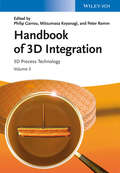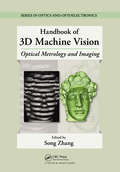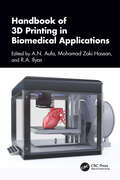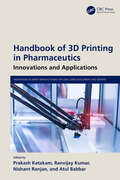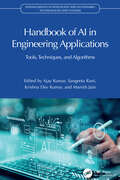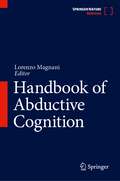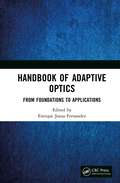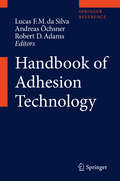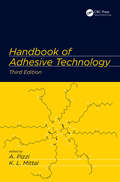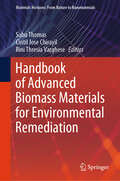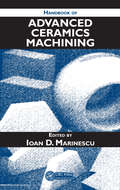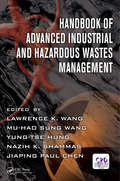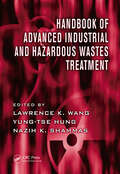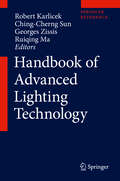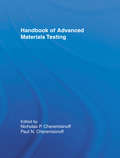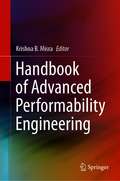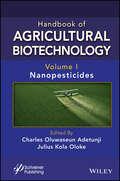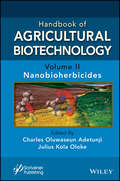- Table View
- List View
Handbook for the Chemical Analysis of Plastic and Polymer Additives
by Michael Bolgar Jack Hubball Joseph Groeger Susan MeronekPolymers have undoubtedly changed the world through many products that improve our lives. However, additives used to modify the overall characteristics of these materials may not be fully disclosed or understood. These additives may present possible environmental and health hazards. It is important to monitor consumer products for these compounds u
Handbook of 3D Integration
by Peter Ramm Philip Garrou Mitsumasa KoyanagiEdited by key figures in 3D integration and written by top authors from high-tech companies and renowned research institutions, this book covers the intricate details of 3D process technology. As such, the main focus is on silicon via formation, bonding and debonding, thinning, via reveal and backside processing, both from a technological and a materials science perspective. The last part of the book is concerned with assessing and enhancing the reliability of the 3D integrated devices, which is a prerequisite for the large-scale implementation of this emerging technology. Invaluable reading for materials scientists, semiconductor physicists, and those working in the semiconductor industry, as well as IT and electrical engineers.
Handbook of 3D Integration: Volume 4: Design, Test, and Thermal Management
by Peter Ramm Philip Garrou Mitsumasa Koyanagi Paul D. Franzon Eric Jan Marinissen Muhannad S. BakirThis fourth volume of the landmark handbook focuses on the design, testing and thermal management of 3D-integrated devices, both from a technological and a materials science perspective. Edited and authored by key figures from top research institutions and high-tech companies, the first part of the book provides an overview of the latest developments in 3D chip design, including the particular challenges and potential. The second part is concerned with the test methods used to assess the quality and reliability of the 3D-integrated devices, while the third and final part deals with thermal management.
Handbook of 3D Machine Vision: Optical Metrology and Imaging (Series in Optics and Optoelectronics)
by Song ZhangChoosing from the numerous 3D vision methods available can be frustrating for scientists and engineers, especially without a comprehensive resource to consult. Filling this gap, this handbook gives an in-depth look at the most popular 3D imaging techniques. Written by key players in the field and inventors of important imaging technologies, it helps you understand the core of 3D imaging technology and choose the proper 3D imaging technique for your needs. For each technique, the book provides its mathematical foundations, summarizes its successful applications, and discusses its limitations.
Handbook of 3D Printing in Biomedical Applications
by R. A. Ilyas A. N. Aufa Mohamad Zaki Hassan3D printing is a promising fabrication technique capable of creating objects with precise structures and shapes based on 3D model data, allowing for versatile alterations and production of intricate shapes while also reducing the consumption of feedstock, particularly crucial in the cost-sensitive realm of medicine. In the biomedical sphere the use of 3D printing spans various applications, from artificial organs to sensors and orthopedic implants. This handbook explores the transformative role of technology in healthcare, focusing on materials, design, and innovation. It covers diverse applications like prosthetics, devices, tissue engineering, and medicine. This comprehensive resource highlights cutting-edge advancements, ethical considerations, and future trends, offering insights for researchers, professionals, and students. Explores the latest advances, technologies, and practical applications of additive manufacturing in biomedical engineering, including its impact on tissue engineering, drug delivery systems, regenerative medicine, and orthodontics Covers polymer 3D bioprinting techniques and advanced materials pivotal for successful biomedical implants in clinical settings Discusses the integration of smart materials and their applications including point-of-care solutions Encompasses various facets of medical technology, including diagnostic instruments, therapeutic devices, tissue engineering, and regenerative medicine Examines both in vivo and in vitro studies related to 3D printing, unraveling their significance and implications in various contexts Considers challenges and future perspectives With its comprehensive approach, this handbook serves as the definitive resource for researchers, practitioners, and advanced students, fostering a deeper appreciation and understanding of the transformative power of 3D printing in shaping the future of biomedical engineering.
Handbook of 3D Printing in Pharmaceutics: Innovations and Applications (Innovations in Smart Manufacturing for Long-Term Development and Growth)
by Ranvijay Kumar Atul Babbar Nishant Ranjan Prakash KatakamThree-dimensional (3D) printing has evolved as an emerging tool for the design of customized or personalized medication that provides the maximum therapeutic benefits to patients. The manufacturing of medicines in small batches customized with tailored dosages, sizes, shapes, and drug release properties is the key prospect of using 3D printing in pharmaceutics.Handbook of 3D Printing in Pharmaceutics: Innovations and Applications provides a detailed and in-depth technical discussion on the various additive manufacturing processes for the development of pharmaceutical products with experimental justification. It details the characterization, optimization, and numerical modeling of the processes involved and outlines the industrial implications of the resulting products as well as offering solutions for patient- tailored drugs processed by additive manufacturing. The handbook goes on to focus on the various post- processing technologies available to fortify the mechanical, chemical, biological, geometrical, and other characteristics of additively manufactured components and also discusses future directions and possible research gaps that need to be filled.The buyers of this cutting-edge handbook will learn the complete information and methodology for manufacturing drug delivery systems and customized medicine for biomedical applications. It is an ideal read for undergraduates, graduates, and postgraduate research scholars. Industrial and academic professionals working and studying industrial, manufacturing, and production engineering, along with those studying mechanical engineering, pharmaceutical sciences, material science, chemical engineering, biomedical engineering, automobile/aerospace engineering, and other relevant domains will want this handbook at their fingertips.
Handbook of AI in Engineering Applications: Tools, Techniques, and Algorithms (Advancements in Intelligent and Sustainable Technologies and Systems)
by Ajay Kumar, Sangeeta Rani, Krishna Dev Kumar, and Manish JainThere is a need to categorize artificial intelligence (AI) applications, tools, techniques, and algorithms based on their intended use in various design stages. Specifically, there is a need to explore AI techniques that are utilized for tasks such as designing, including but not limited to inspiration, idea and concept generation, concept evaluation, optimization, decision-making, and modeling. This includes things like generating ideas and concepts, evaluating those ideas, optimizing designs, making decisions, and creating models. This handbook brings all of these categories with compatible AI techniques, tools, and algorithms together in one place.Handbook of AI in Engineering Applications: Tools, Techniques, and Algorithms covers applications of AI in engineering and highlights areas such as future cities, mechanical system analysis, and robotic process automation, and presents the application of AI and the use of computerized systems that aim to simplify and automate the processes of design and construction of civil works. The handbook discusses the design and optimization of mechanical systems and parts, such as engines, gears, and bearings, which can be automated using AI and it explores the performance of robotics and automation systems which can be simulated and analyzed using AI to forecast behavior, spot future issues, and suggest changes. Rounding out this handbook is AI technology automation and how analyzing relevant data can provide a reliable basis for relevant personnel to carry out their work.This handbook fills the gap between R&D in AI and will benefit all stakeholders including industries, professionals, technologists, academics, research scholars, senior graduate students, government, and public healthcare professionals.
Handbook of AI-Based Mechatronics Systems and Smart Solutions in Industrial Automation (Intelligent Manufacturing and Industrial Engineering)
by Vandana Sharma Pushpalatha Naveenkumar Gunapriya DevarajanArtificial intelligence (AI) and mechatronics are booming areas where most of the industrial sectors are becoming smart nowadays. This handbook includes material of multidisciplinary content from the AI, mechanical, and electronics engineering domains, among others. It gives insights into various application sectors discussing current global developments in mechatronics employing AI technology and addressing the complexity of current issues and the effects of diverse mechatronics systems.Handbook of AI-Based Mechatronics Systems and Smart Solutions in Industrial Automation focuses on system automation, predictive analysis, preventive analysis, and real-time decision-making systems for next-generation automation. It discusses the advancements of mechatronics systems using AI applications along with the global approach toward smart industrial automation and presents the impact of AI on today’s work of autonomous and industrial automation. The book discusses future research potential and is beneficial to manufacturing, healthcare, and finance disputes, while it offers AI algorithms to analyze large amounts of data and identifies patterns, trends, and anomalies for accurate predictions and optimization processes. The handbook also addresses use cases and case studies related to AI in mechatronics along with applications.Scholars in the field of AI in mechatronics and related applications will find this book useful. In particular, attention is drawn to both fundamental ideas and important practical contexts. Readers interested in the most recent findings in the field of problem-oriented processing approaches in mechatronics, including those in academia, data science, industry, research, and graduate and undergraduate students, will find this fascinating handbook extremely interesting.
Handbook of AI-Based Models in Healthcare and Medicine: Approaches, Theories, and Applications (Artificial Intelligence in Smart Healthcare Systems)
by Bhanu Chander, Koppala Guravaiah, B. Anoop, and G. KumaravelanThis handbook provides thorough, in-depth, and well-focused developments of artificial intelligence (AI), machine learning (ML), deep learning (DL), natural language processing (NLP), cryptography, and blockchain approaches, along with their applications focused on healthcare systems.Handbook of AI-Based Models in Healthcare and Medicine: Approaches, Theories, and Applications highlights different approaches, theories, and applications of intelligent systems from a practical as well as a theoretical view of the healthcare domain. It uses a medically oriented approach in its discussions of human biology, healthcare, and medicine and presents NLP-based medical reports and medicine enhancements. The handbook includes advanced models of ML and DL for the management of healthcare systems and also discusses blockchain-based healthcare management. In addition, the handbook offers use cases where AI, ML, and DL can help solve healthcare complications.Undergraduate and postgraduate students, academicians, researchers, and industry professionals who have an interest in understanding the applications of ML/DL in the healthcare setting will want this reference on their bookshelf.
Handbook of AI-Driven Threat Detection and Prevention: A Holistic Approach to Security
by Pankaj Bhambri A. Jose AnandIn today’s digital age, the risks to data and infrastructure have increased in both range and complexity. As a result, companies need to adopt cutting-edge artificial intelligence (AI) solutions to effectively detect and counter potential threats. This handbook fills the existing knowledge gap by bringing together a team of experts to discuss the latest advancements in security systems powered by AI. The handbook offers valuable insights on proactive strategies, threat mitigation techniques, and comprehensive tactics for safeguarding sensitive data.Handbook of AI-Driven Threat Detection and Prevention: A Holistic Approach to Security explores AI-driven threat detection and prevention, and covers a wide array of topics such as machine learning algorithms, deep learning, natural language processing, and so on. The holistic view offers a deep understanding of the subject matter as it brings together insights and contributions from experts from around the world and various disciplines including computer science, cybersecurity, data science, and ethics. This comprehensive resource provides a well-rounded perspective on the topic and includes real-world applications of AI in threat detection and prevention emphasized through case studies and practical examples that showcase how AI technologies are currently being utilized to enhance security measures. Ethical considerations in AI-driven security are highlighted, addressing important questions related to privacy, bias, and the responsible use of AI in a security context. The investigation of emerging trends and future possibilities in AI-driven security offers insights into the potential impact of technologies like quantum computing and blockchain on threat detection and prevention.This handbook serves as a valuable resource for security professionals, researchers, policymakers, and individuals interested in understanding the intersection of AI and security. It equips readers with the knowledge and expertise to navigate the complex world of AI-driven threat detection and prevention. This is accomplished by synthesizing current research, insights, and real-world experiences.
Handbook of Abductive Cognition
by Lorenzo MagnaniThis Handbook offers the first comprehensive reference guide to the interdisciplinary field of abductive cognition, providing readers with extensive information on the process of reasoning to hypotheses in humans, animals, and in computational machines. It highlights the role of abduction in both theory practice: in generating and testing hypotheses and explanatory functions for various purposes and as an educational device. It merges logical, cognitive, epistemological and philosophical perspectives with more practical needs relating to the application of abduction across various disciplines and practices, such as in diagnosis, creative reasoning, scientific discovery, diagrammatic and ignorance-based cognition, and adversarial strategies. It also discusses the inferential role of models in hypothetical reasoning, abduction and creativity, including the process of development, implementation and manipulation for different scientific and technological purposes. Written by a group of internationally renowned experts in philosophy, logic, general epistemology, mathematics, cognitive, and computer science, as well as life sciences, engineering, architecture, and economics, the Handbook of Abductive Cognition offers a unique reference guide for readers approaching the process of reasoning to hypotheses from different perspectives and for various theoretical and practical purposes. Numerous diagrams, schemes and other visual representations are included to promote a better understanding of the relevant concepts and to make concepts highly accessible to an audience of scholars and students with different scientific backgrounds.
Handbook of Adaptive Optics: From Foundations to Applications
by Enrique Josua FernandezAdaptive Optics (AO) is a technique allowing the manipulation of the wavefront of the light benefitting multiple fields like Microscopy, Optical Coherence Tomography, Visual Testing, Optical Communications, and Astronomical Optics, just to mention some examples. Handbook of Adaptive Optics contains a complete picture of the technique from the foundations to the most promising applications of AO in a variety of fields.Within this book, the reader will find different sections, including: a complete and rigorous introduction to the foundation of the technique from a general perspective, providing the reader a solid basis in AO with particular emphasis on wavefront sensing methods and aberration correctors. It also discusses state-of-the-art applications and industrial usages with their particular constraints and methods to incorporate AO, like in some imaging techniques of importance for Biomedical Optics, in Astronomy and for Visual Optics. Furthermore, it explores discussions of the future of AO together with some of the most exciting emerging applications, including quantum technologies, scattering correction, space telescopes, and discrete AO, among others.This timely handbook will be an important companion to those starting in the field, but it will also serve as a comprehensive resource for researchers and experts who are already working with AO.
Handbook of Adhesion Technology
by Andreas Öchsner Robert D. Adams Lucas F. SilvaAdhesives have been used for thousands of years, but until 100 years ago, the vast majority was from natural products such as bones, skins, fish, milk, and plants. Since about 1900, adhesives based on synthetic polymers have been introduced, and today, there are many industrial uses of adhesives and sealants. It is difficult to imagine a product--in the home, in industry, in transportation, or anywhere else for that matter--that does not use adhesives or sealants in some manner. The Handbook of Adhesion Technology is intended to be the definitive reference in the field of adhesion. Essential information is provided for all those concerned with the adhesion phenomenon. Adhesion is a phenomenon of interest in diverse scientific disciplines and of importance in a wide range of technologies. Therefore, this handbook includes the background science (physics, chemistry and materials science), engineering aspects of adhesion and industry specific applications. It is arranged in a user-friendly format with ten main sections: theory of adhesion, surface treatments, adhesive and sealant materials, testing of adhesive properties, joint design, durability, manufacture, quality control, applications and emerging areas. Each section contains about five chapters written by internationally renowned authors who are authorities in their fields. This book is intended to be a reference for people needing a quick, but authoritative, description of topics in the field of adhesion and the practical use of adhesives and sealants. Scientists and engineers of many different backgrounds who need to have an understanding of various aspects of adhesion technology will find it highly valuable. These will include those working in research or design, as well as others involved with marketing services. Graduate students in materials, processes and manufacturing will also want to consult it.
Handbook of Adhesion Technology
by Andreas Öchsner Robert D. Adams Lucas F. M. da SilvaThis 2nd edition is a complete revision with an update of the methods that have been investigated recently and that are now fully accepted by the adhesion community. Themes that are now treated in more detail include for example hybrid adhesives used for automotive applications, ecofriendly surface treatments, damage mechanics, joint durability prediction and functionally graded joints. There is also a new chapter related to the application of adhesives in the oil industry. Besides these content changes, there has been a complete revision of all chapters in terms of text, figures, tables and references for a more didactic character of this reference book. The Handbook of Adhesion Technology is intended to be the definitive reference in the field. Essential information is provided for all those concerned with adhesion, which is a phenomenon of interest in diverse scientific disciplines and of importance in a wide range of technologies. Therefore, this book includes the background science (physics, chemistry and materials science), engineering aspects and industry-specific applications. It is arranged in a user-friendly format with ten main sections: theory of adhesion, surface treatments, adhesive and sealant materials, testing of adhesive properties, joint design, durability, manufacture, quality control, applications and emerging areas. Each section contains about five chapters written by internationally renowned authors who are authorities in their fields. This book offers a quick, but authoritative, description of topics in the field of adhesion and the practical use of adhesives and sealants. Scientists and engineers of many different backgrounds who need to have an understanding of various aspects of adhesion technology will find it highly valuable. These will include those working in research or design, as well as others involved with marketing services. Graduate students in materials, processes and manufacturing will also want to consult it.
Handbook of Adhesive Technology
by Antonio Pizzi Kashmiri L. MittalThis classic reference examines the mechanisms driving adhesion, categories of adhesives, techniques for bond formation and evaluation, and major industrial applications. Integrating recent innovation and improved instrumentation, the work offers broad and comprehensive coverage. This edition incorporates several new adhesive classes, new application topics, and recent developments with nanoadhesives and bio-based adhesives. Existing chapters are thoroughly updated, revised, or replaced and authored by top specialists in the field. Abundant figures, tables, and equations appear throughout the work.
Handbook of Advanced Biomass Materials for Environmental Remediation (Materials Horizons: From Nature to Nanomaterials)
by Sabu Thomas Cintil Jose Chirayil Rini Thresia VargheseThis book explores the functional materials derived from biomass for environmental remediation applications. It covers different sources of biomass, its classification, production and various functional materials that are derived from them and suitable for energy production. Various topics covered in this book include classification of biomass, conversion and utilization techniques, functional materials, different applications in environmental remediation, biofuels and many more. This book is highly useful for students, researchers and professionals working in the field of materials and environmental science.
Handbook of Advanced Ceramics Machining
by Ioan D. MarinescuCeramics, with their unique properties and diverse applications, hold the potential to revolutionize many industries, including automotive and semiconductors. For many applications, ceramics could replace metals and other materials that are more easily and inexpensively machined. However, current ceramic machining methods remain cost-prohibitive. F
Handbook of Advanced Industrial and Hazardous Wastes Management (Advances in Industrial and Hazardous Wastes Treatment #7)
by Lawrence K. Wang Yung-Tse Hung Nazih K. Shammas Jiaping Paul Chen Mu-Hao S. WangThis volume provides in-depth coverage of environmental pollution sources, waste characteristics, control technologies, management strategies, facility innovations, process alternatives, costs, case histories, effluent standards, and future trends in waste treatment processes. It delineates methodologies, technologies, and the regional and global effects of important pollution control practices. It focuses on specific industrial and manufacturing wastes and their remediation. Topics include: heavy metals, electronics, chemical, and textile manufacturing.
Handbook of Advanced Industrial and Hazardous Wastes Treatment (Advances in Industrial and Hazardous Wastes Treatment #7)
by Lawrence K. Wang Yung-Tse Hung Nazih K. ShammasMost industrial and hazardous waste management resources cover the major industries and provide conventional in-plant pollution control strategies. Until now however, no book or series of books has provided coverage that includes the latest developments in innovative and alternative environmental technology, design criteria, managerial decision met
Handbook of Advanced Lighting Technology
by Robert Karlicek Ching-Cherng Sun Georges Zissis Ruiqing MaThe Handbook of Advanced Lighting Technology is a major reference work on the subject of light source science and technology, with particular focus on solid-state light sources - LEDs and OLEDs - and the development of 'smart' or 'intelligent' lighting systems; and the integration of advanced light sources, sensors, and adaptive control architectures to provide tailored illumination which is 'fit to purpose. ' The concept of smart lighting goes hand-in-hand with the development of solid-state light sources, which offer levels of control not previously available with conventional lighting systems. This has impact not only at the scale of the individual user, but also at an environmental and wider economic level. These advances have enabled and motivated significant research activity on the human factors of lighting, particularly related to the impact of lighting on healthcare and education, and the Handbook provides detailed reviews of work in these areas. The potential applications for smart lighting span the entire spectrum of technology, from domestic and commercial lighting, to breakthroughs in biotechnology, transportation, and light-based wireless communication. Whilst most current research globally is in the field of solid-state lighting, there is renewed interest in the development of conventional and non-conventional light sources for specific applications. This Handbook comprehensively reviews the basic physical principles and device technologies behind all light source types and includes discussion of the state-of-the-art. The book essentially breaks down into five major sections: Section 1: The physics, materials, and device technology of established, conventional, and emerging light sources, Section 2: The science and technology of solid-state (LED and OLED) light sources, Section 3: Driving, sensing and control, and the integration of these different technologies under the concept of smart lighting, Section 4: Human factors and applications, Section 5: Environmental and economic factors and implications
Handbook of Advanced Materials Testing (Materials Engineering)
by Nicholas P. Cheremisinoff Paul N. CheremisinoffThis work discusses techniques for developing new engineering materials such as elastomers, plastic blends, composites, ceramics and high-temperature alloys. Instrumentation for evaluating their properties and identifying potential end uses are presented.;The book is intended for materials, manufacturing, mechanical, chemical and metallurgical engi
Handbook of Advanced Performability Engineering
by Krishna B. MisraThis book considers all aspects of performability engineering, providing a holistic view of the activities associated with a product throughout its entire life cycle of the product, as well as the cost of minimizing the environmental impact at each stage, while maximizing the performance. Building on the editor's previous Handbook of Performability Engineering, it explains how performability engineering provides us with a framework to consider both dependability and sustainability in the optimal design of products, systems and services, and explores the role of performability in energy and waste minimization, raw material selection, increased production volume, and many other areas of engineering and production. The book discusses a range of new ideas, concepts, disciplines, and applications in performability, including smart manufacturing and Industry 4.0; cyber-physical systems and artificial intelligence; digital transformation of railways; and asset management. Given its broad scope, it will appeal to researchers, academics, industrial practitioners and postgraduate students involved in manufacturing, engineering, and system and product development.
Handbook of Agri-Food Law in China, Germany, European Union: Food Security, Food Safety, Sustainable Use of Resources in Agriculture
by Ines HärtelThis book offers a new and differentiated overview of Agri-Food Law against the background of national and global integration of markets, and compares for the first time important aspects of the agricultural, environmental and food law of China and Germany / the European Union. In addition to the basics, it discusses a wide range of issues, such as the respective legal regulatory structures for food security, food safety, geographical indications of origin, climate protection, fertilizers, plant protection products, genetic engineering, water protection, soil protection, land resources and organic farming. In addition, it addresses key environmental impacts and developments in order to create integrated value chains. The increasing fusion of upstream and downstream areas is becoming apparent from primary production, to the refinement and trade up level, and even to consumption. Agri-Food Law is now productively taking these important developments into account with regard to the aforementioned countries.
Handbook of Agricultural Biotechnology, Volume 1: Nanopesticides (Handbook of Agricultural Bionanobiotechnology)
by Charles Oluwaseun Adetunji Julius Kola OlokeHandbook of AGRICULTURAL BIOTECHNOLOGY The book provides detailed information on the application of nanopesticides for the management of numerous agricultural pests and pathogens, as well as to foster an innovative pathway toward future sustainable agriculture and food systems. Biopesticides have been identified as a sustainable and permanent replacement to synthetic chemicals. Their application will go a long way toward preventing major challenges that confront sustainable agriculture, the actualization of global food production and food security, helping to feed an ever-increasing population that is predicted to increase to nine billion by 2050. An interdisciplinary collaboration among policymakers, private sector, researchers, civil society, farmers, consumers, and environmentalists will foster an innovative pathway toward future sustainable agriculture and food systems that could ensure resilience, food security, and a healthy environment. The book explains the application of some nanobiopesticides as ovicides that could kill eggs of insects and mites, as well as slimicides that could destroy slime-producing microorganisms, such as algae, bacteria, fungi, and slime molds. Other highlights include: a discussion on the application of nanobiopesticides for the rejuvenation of heavily contaminated environments (as well as their role in the mitigation of several abiotic stress); a demonstration of how nanobiopesticides derived from plants could be applied for effective management of pests and diseases in animal husbandry and fishery; and a collection of relevant information on patents, the commercialization of relevant plant-derived nanobiopesticides, and their social economic and industrial relevance. Audience The book is a useful resource for a diverse audience, including industrialists, food industry professionals, agriculturists, agricultural microbiologists, plant pathologists, botanists, microbiologists, biotechnologists, nanotechnologists, microbial biotechnologists, farmers, policymakers, and extension workers.
Handbook of Agricultural Biotechnology, Volume 2: Nanobioherbicides (Handbook of Agricultural Bionanobiotechnology)
by Charles Oluwaseun Adetunji Julius Kola OlokeHandbook of AGRICULTURAL BIOTECHNOLOGY The book provides a detailed examination of the application of nanobioherbicides that come from plants including information on the different metabolites derived from numerous plants that could become bioherbicides. The book gives attention to weed-plant physiology and chronicles the activities of nanobioherbicides on weeds during preliminary bioassays, pot assays, in-house screenings, and during field trials. Furthermore, deep data is provided on the commercial potential of these nanobioherbicides derived from plants, while toxicity assays are also highlighted. Other topics covered include: documented patents on nanobioherbicides; the process involved in the registration of these novel products as nanobioherbicides for both conventional and organic farming; relevant information on the application of molecular techniques for improvement of nanobioherbicides, such as genomics, proteomics, informatics, bioinformatics, and chemoinformatics; details about the non-target effect of the nanobioherbicides. Highlighted, too, is information on the biochemical, enzymatic, and ultrastructural effects of these nanobioherbicides, as well as detailed information on the nutritional qualities of agricultural crops after nanobioherbicidal application. Audience The book is a useful resource for a diverse audience, including industrialists, food industry professionals, agriculturists, agricultural microbiologists, plant pathologists, botanists, microbiologists, biotechnologists, nanotechnologists, microbial biotechnologists, farmers, policymakers, and extension workers.

